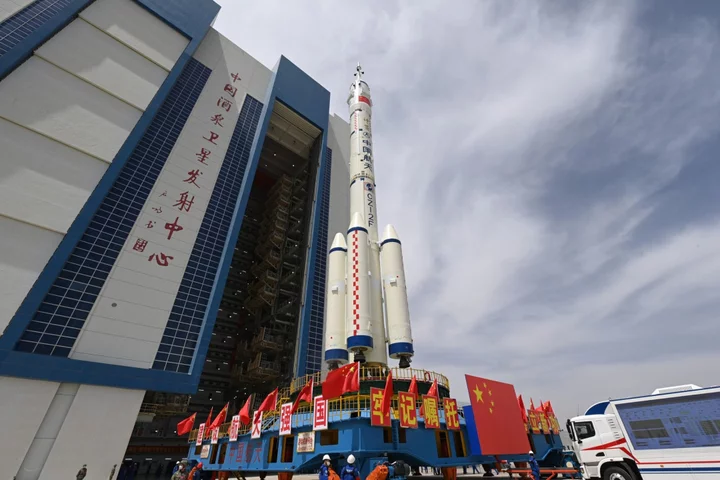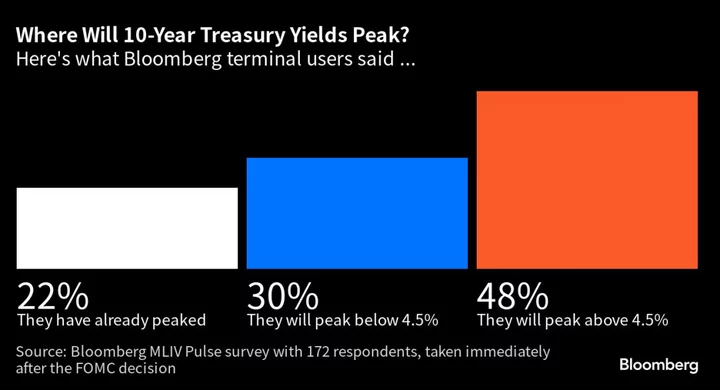China’s Shenzhou 16 mission blasted off from deep in the Gobi Desert, showcasing the space program’s rapid progress at a time when the US is trying to thwart Beijing’s development of sophisticated industries such as semiconductors.
A Long March-2F rocket sending three astronauts to the Chinese space station took off from the military-controlled Jiuquan Satellite Launch Center on Tuesday morning, state media reported.
The launch marked the 11th crewed mission for China as it narrows the gap in a head-to-head space race with the US.
China has notched up an impressive series of achievements in recent years, becoming the first nation to land a craft on the far side of the moon in 2019 and landing a rover on Mars in 2021. It’s also the only country operating its own space station, built after the US objected to Chinese participation in the multinational International Space Station.
The country plans to send Chinese astronauts to the moon by 2030, China Manned Space Agency official Lin Xiqiang said at a briefing on Monday.
In the days before Shenzhou 16’s takeoff, the government allowed foreign reporters to visit the launch center, shoot video and take photos, an unusual gesture given the area is controlled by the People’s Liberation Army. Underscoring the PLA’s role in the Chinese space program, a billboard at the entrance to the center shows President Xi Jinping with the slogan “Dream of Space, Dream of a Strong Military.”
“China has achieved operational success when it comes to its space achievements and is now on a path to commercialize space,” said Namrata Goswami, an independent scholar on space policy and author of a book on great-power competition in space. “Inviting foreign media gives them visibility as well as showcases that confidence.”
As the Chinese agency competes with NASA to send astronauts to the moon for the first time since 1972, greater visibility for Beijing’s space program could also boost its efforts to gain support among countries taking part in its Belt and Road Initiative, Xi’s campaign to use infrastructure projects to increase Chinese influence, she added.
“The audience is not just the United States but also partner nations along the Belt and Road Initiative,” Goswami said.
Image Repair
A self-enclosed community for staff of the space agency who often stroll around the area in their official blue jumpsuits, the center is usually a destination for tour groups and students. However, its streets, parks and strip mall were largely empty the day before the Shenzhou-16 mission because tourists cannot visit around the time of launches.
Xi has been tapping into the space program as part of a charm offensive aimed at repairing its global image, battered by his Covid Zero policy which largely isolated the country before he abruptly ended it late last year.
“China is willing to work with other countries to strengthen exchanges and cooperation, jointly explore the mysteries of the universe, make peaceful use of outer space, and promote space technology to better benefit the people of all countries in the world,” he said in a letter to a UN symposium in November.
So far, no country has taken up Xi’s offer to send their astronauts into space aboard a Chinese rocket. The European Space Agency had two astronauts participate in a training mission with Chinese counterparts in 2017, with the goal of eventually sending European astronauts to the Chinese space station, but in January this year the agency’s director general said the ESA had no plans for such a mission.
“Giving up cooperation with China in the manned space domain is clearly short-sighted, which reveals that the US-led camp confrontation has led to a new space race,” the Global Times newspaper reported after the ESA announcement.
Meanwhile, the US continues to make progress in its space diplomacy. Two dozen countries support the Washington-backed Artemis Accords to create a framework for space activity. One of Elon Musk’s SpaceX rockets on May 21 launched four astronauts to the International Space Station, including the first woman from Saudi Arabia to travel to space.
In the latest iteration of Shenzhou, which means “Divine Craft,” the three Chinese astronauts are expected to rendezvous with three others who have been living aboard the Tiangong space station, part of the government’s plans to have it occupied continuously. They will conduct scientific experiments and spacewalks in the coming months.
The crew includes China’s first civilian astronaut to go to space, Gui Haichao, a professor at Beihang University in Beijing.
--With assistance from Amanda Wang.
(Updates with information on crew in final paragraph.)









